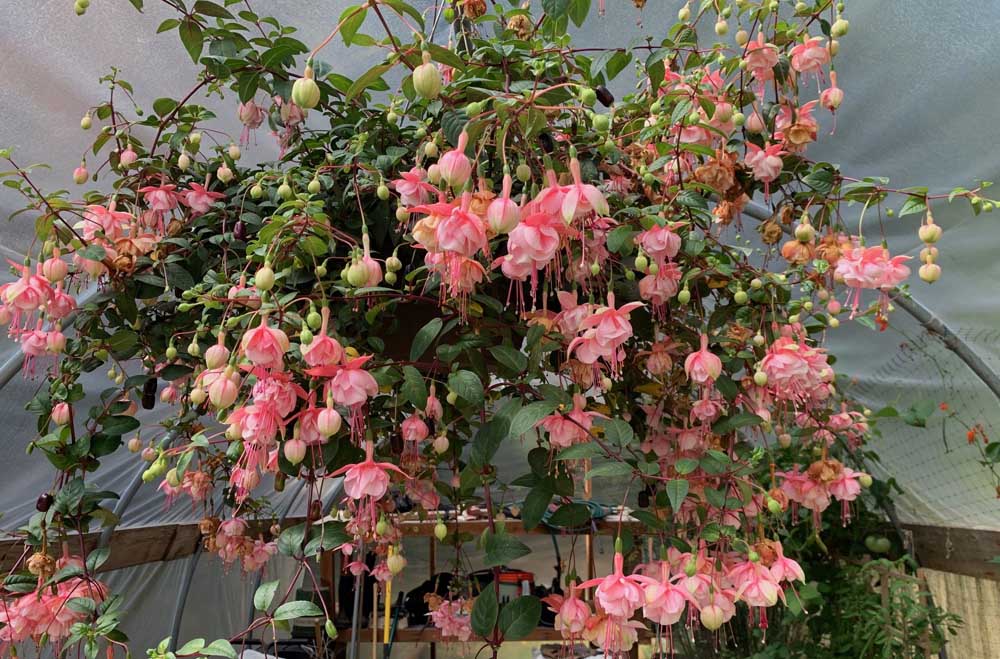GARDEN PLOTS: My covenant with a potted fuchsia called ‘Claudia’
Published 6:00 am Wednesday, September 6, 2023

- Fuchsia x hybrida "Claudia" is a trailing variety of tender perennial fuchsia that blooms all summer and into the fall. During the long flowering season, Claudia requires plenty of water but needs good drainage so the roots don’t rot. The author gives her potted hanging fuchsia about two gallons of water every day.
“… I put out my hand and stroke
Trending
the fine, dry grit of their skins.
After all,
we are partners in this land,
Trending
co-signers of a covenant.
At my touch the wild
braid of creation
trembles.”
— From “The Snakes of September,” in Stanley Kunitz’s “The Wild Braid,” 2007
“The Wild Braid” is a lovely book for which poet Stanley Kunitz, 100 years old at the time the book was written, shared insights about writing and gardening with fellow author and gardener Genine Lentine. Kunitz’s reflections on a life creatively spent are even more poignant accompanied by photographs by Marnie Crawford Samuelson taken of him working and resting in his seaside garden in Provincetown, Massachusetts.
The title of the book comes from a phrase Kunitz used to describe a couple of garden snakes that, during the last weeks of summer, found the sun’s dwindling warmth by hanging from the branches of an old spruce tree, “dangling head-down entwined/in a brazen love-knot.” The snakes became so used to his presence that Kunitz told Lentine, “I felt they were actually waiting for me to appear, that it had become a part of their ritual for survival.” He called his relationship with the snakes a covenant, a pledge to peacefully co-exist in their shared space — his garden, their home.
I’m drawn to the word covenant to describe the connection I have with the plants in my garden. Covenant is an Old French word, originating from the Latin root convenire, “to come together.” That’s exactly what gardening is — a coming together of people, plants and animals with the sun, soil and water to form a living braid that is part wild, part tamed.
This summer, I made a covenant with a fabulous fuchsia hybrid called “Claudia.” It all started with a hummingbird that kept flying into my hoop house because it was attracted to the scarlet runner bean flowers and the red-flowered strawberry plants. The hummingbird never stayed long, though, so I wanted to add a hanging plant that would provide plenty of nectar until fall. A trailing fuchsia fit the bill perfectly.
Not only do many fuchsia cultivars bloom continuously from early summer to fall, but their exotic flowers, mostly in the pink to purple range, also brighten any sunny room or outdoor patio. Claudia has pale pink, double flowers with deeper pink veins and stamens that contrast beautifully with her dark-green foliage. The deeper pink color in the flowers matches the plant’s young branches and leaf veins. It didn’t take long for Claudia and the hummingbird (and many bees) to make their acquaintance.
Claudia is, indeed, spectacular, but she is one high-maintenance lady. After swooning over her beauty at the plant nursery, I balked when I learned she needs to be watered twice a day — nearly a gallon for each watering — during her long growing season. I was also told the soil in her pot needs to be replenished once a week with a balanced fertilizer. I’ve never watered any potted plant twice a day before, so I wasn’t sure I wanted to sign up for that level of care.
But Claudia called out to me, and no other plant at the nursery came close to being as pretty, as floriferous, or as much of a hummingbird magnet. I brought her home, hung her in the hoop house, and (in my mind) we made a mutual pledge: I will provide all the water and fertilizer she needs to be happy, and she will provide an abundance of blossoms from June through October for the hummingbirds, pollinating insects and me. (A bonus is that fuchsia flowers and fruits are edible; Claudia’s dark purple berries taste a lot like plums.)
As a tender perennial type of fuchsia, Claudia will not tolerate freezing temperatures. I’ll need to bring her indoors to overwinter, and a couple of weeks before then I’ll cut back on watering to once a week. After I bring her inside, she’ll only need watering once a month. She’s a deciduous plant, so she will lose most of her foliage during her dormancy and I’ll remove any lingering leaves to protect against overwintering pests.
In the spring after the last frost, I’ll prune the branches halfway back (flowers bloom on new growth) and acclimate Claudia to more sunshine by bringing her outdoors into partial shade at first. Spring is also a good time to move her into a bigger pot with fresh soil and compost. Around May, I’ll need to start her normal watering and fertilizing routine again.
Healthy fuchsias can live for several years, so my relationship with Claudia might be a long-term one. Stanley Kunitz said, “… There is nothing in the range of human experience that is separate from what the garden can signify in its eagerness and its insistence.” I suppose making a covenant with a potted fuchsia is one example of what he meant.









